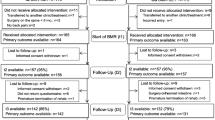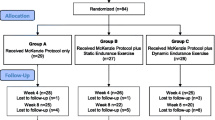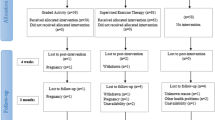Abstract
The aim of this study was to explore on which variables a stress reduction program based on heart coherence can enhance the effects of a back school (BS) in patients with chronic non-specific low back pain and to explore possible moderators for treatment success. A retrospective explorative design was carried out with 170 patients with chronic non-specific low back pain. 89 Patients were admitted to BS and 81 patients were selected for BS and heart coherence training (BS–HCT). Six sessions of heart coherence were provided. At T0 (baseline) and T1 (discharge), the Numeric Rating Scale for pain (NRS pain), Roland Morris Disability Questionnaire (RMDQ), Pain Disability Index (PDI) and Rand-36 were administered in both groups. Both groups improved significantly on NRS pain, RMDQ, PDI and most of the Rand-36 subscales. On physical functioning, the BS–HCT group improved significantly more than the BS group (p = 0.02) but not after Bonferroni correction. Significant moderate correlations (r = 0.39 and r = 0.48) were found between the change of heart coherence and change of PDI and RMDQ respectively, but not with other variables. Baseline characteristics were not related to change on heart coherence. Providing HCT was more effective on physical functioning compared to a BS program. Change in heart coherence was related significantly to 2 out of 12 analyses. Placebo controlled and blinded studies are needed to confirm this. Characteristics of individuals who might benefit remain unknown. Evidence of this study is considered a level C, because of its pragmatic clinical character.
Similar content being viewed by others
References
Agelink, M. W., Boz, C., Ullrich, H., & Andrich, J. (2002). Relationship between major depression and heart rate variability: Clinical consequences and implications for antidepressive treatment. Psychiatry Research, 113(1–2), 139–149.
Bekkering, G. E., Hendriks, H. J. M., Koes, B. W., Oostendorp, R. A. B., Ostelo, R. W. J. G., Thomassen, J., et al. (2005). KNGF richtlijn Lage-rugpijn. No. 115.
Berntson, G. G., Cacioppo, J. T., & Quigley, K. S. (1993). Respiratory sinus arrhythmia: Autonomic origins, physiological mechanisms, and psychophysiological implications. Psychophysiology, 30(2), 183–196.
Breivik, H., Collett, B., Ventafridda, V., Cohen, R., & Gallacher, D. (2006). Survey of chronic pain in Europe: Prevalence, impact on daily life, and treatment. European Journal of Pain (London, England), 10(4), 287–333.
Busija, L., Osborne, R. H., Nilsdotter, A., Buchbinder, R., & Roos, E. M. (2008). Magnitude and meaningfulness of change in SF-36 scores in four types of orthopedic surgery. Health and Quality of Life Outcomes, 6, 55.
Cohen, J. (1988). Statistical power analysis for the behavioral sciences (2nd ed.). New Jersey: Hillsdale.
Dekker, J. M., Crow, R. S., Folsom, A. R., Hannan, P. J., Liao, D., Swenne, C. A., et al. (2000). Low heart rate variability in a 2-minute rhythm strip predicts risk of coronary heart disease and mortality from several causes: The ARIC Study. Atherosclerosis Risk in Communities. Circulation, 102(11), 1239–1244.
Gockel, M., Lindholm, H., Niemisto, L., & Hurri, H. (2008). Perceived disability but not pain is connected with autonomic nervous function among patients with chronic low back pain. Journal of Rehabilitation Medicine: Official Journal of the UEMS European Board of Physical and Rehabilitation Medicine, 40(5), 355–358.
Goedhart, A. D., Willemsen, G., Houtveen, J. H., Boomsma, D. I., & De Geus, E. J. (2008). Comparing low frequency heart rate variability and preejection period: Two sides of a different coin. Psychophysiology, 45(6), 1086–1090.
Hallman, D. M., & Lyskov, E. (2012). Autonomic regulation, physical activity and perceived stress in subjects with musculoskeletal pain: 24-hour ambulatory monitoring. International Journal of Psychophysiology: Official Journal of the International Organization of Psychophysiology, 86(3), 276–282.
Hallman, D. M., Olsson, E. M., von Scheele, B., Melin, L., & Lyskov, E. (2011). Effects of heart rate variability biofeedback in subjects with stress-related chronic neck pain: A pilot study. Applied Psychophysiology and Biofeedback, 36(2), 71–80.
Hassett, A. L., Radvanski, D. C., Vaschillo, E. G., Vaschillo, B., Sigal, L. H., Karavidas, M. K., et al. (2007). A pilot study of the efficacy of heart rate variability (HRV) biofeedback in patients with fibromyalgia. Applied Psychophysiology and Biofeedback, 32(1), 1–10.
Hay, E. M., Mullis, R., Lewis, M., Vohora, K., Main, C. J., Watson, P., et al. (2005). Comparison of physical treatments versus a brief pain-management programme for back pain in primary care: A randomised clinical trial in physiotherapy practice. Lancet, 365(9476), 2024–2030.
HeartMath. (2004). emWave stress relief system.
Heimer, L., & Van Hoesen, G. W. (2006). The limbic lobe and its output channels: Implications for emotional functions and adaptive behavior. Neuroscience and Biobehavioral Reviews, 30(2), 126–147.
Houtveen, J. H., Hornsveld, H. K., van Trier, J., & van Doornen, L. J. (2012). Questioning the mechanism behind slow breathing and heart coherence training (Vraagtekens bij het werkingsmechanisme van slow-breathing en hartcoherentietraining). Tijdschrift Voor Psychiatrie, 54(10), 879–888.
Jensen, M. P., Karoly, P., & Braver, S. (1986). The measurement of clinical pain intensity: A comparison of six methods. Pain, 27(1), 117–126.
Kang, J. H., Chen, H. S., Chen, S. C., & Jaw, F. S. (2012). Disability in patients with chronic neck pain: Heart rate variability analysis and cluster analysis. The Clinical Journal of Pain, 28(9), 797–803.
Keefe, F. J., Rumble, M. E., Scipio, C. D., Giordano, L. A., & Perri, L. M. (2004). Psychological aspects of persistent pain: Current state of the science. The Journal of Pain: Official Journal of the American Pain Society, 5(4), 195–211.
Kleen, M., & Reitsma, B. (2011). Appliance of heart rate variability biofeedback in acceptance and commitment therapy: A pilot study (null). Journal of Neurotherapy, 15(2), 170–181.
Lane, R. D., McRae, K., Reiman, E. M., Chen, K., Ahern, G. L., & Thayer, J. F. (2009). Neural correlates of heart rate variability during emotion. NeuroImage, 44(1), 213–222.
Lehrer, P. M., Vaschillo, E., Vaschillo, B., Lu, S. E., Eckberg, D. L., Edelberg, R., et al. (2003). Heart rate variability biofeedback increases baroreflex gain and peak expiratory flow. Psychosomatic Medicine, 65(5), 796–805.
Lemaire, J. B., Wallace, J. E., Lewin, A. M., de Grood, J., & Schaefer, J. P. (2011). The effect of a biofeedback-based stress management tool on physician stress: A randomized controlled clinical trial. Open Medicine: A Peer-Reviewed, Independent, Open-Access Journal, 5(4), e154–e163.
McCraty, R. (2001). Science of the heart: Exploring the role of the heart in human performance [null]. Boulder Creek, CA: HearthMath Research Center.
McCraty, R., Atkinson, M., Tomasino, D., & Trevor Bradley, R. (2009). The coherent heart: Heart–brain interactions, psychophysiological coherence, and the emergence of system-wide order. HeartMath Research Center, 5(2), 10–115.
McCraty, R., & Tomasino, D. (2006). Emotional stress, positive emotions, and psychophysiological coherence. In B. B. Arnetz & R. Ekman (Eds.), Stress in health and disease (pp. 342–365). Germany: Weinheim.
McCraty, R., & Watkins, A. D. (1996). Autonomic assessment report: A comprehensive heart rate variability analysis. Boulder Creek, CA: Institute of Heart Math.
Portney, L. G., & Watkins, M. P. (2000). Foundations of clinical research: Applications to practice (2nd ed.). Upper Saddle River: Prentice Hall.
Roland, M., & Morris, R. (1983). A study of the natural history of back pain: Part I: Development of a reliable and sensitive measure of disability in low-back pain. Spine, 8(2), 141–144.
Smeets, R. J., Vlaeyen, J. W., Hidding, A., Kester, A. D., van der Heijden, G. J., & Knottnerus, J. A. (2008). Chronic low back pain: Physical training, graded activity with problem solving training, or both? The 1-year post-treatment results of a randomized controlled trial. Pain, 134(3), 263–276.
Soer, R., Reneman, M. F., Vroomen, P. C., Stegeman, P., & Coppes, M. H. (2012). Responsiveness and minimal clinically important change of the Pain Disability Index in patients with chronic back pain. Spine, 37(8), 711–715.
Stein, P. K., & Kleiger, R. E. (1999). Insights from the study of heart rate variability. Annual Review of Medicine, 50, 249–261.
Taelman, J., Vandeput, S., Gligorijevic, I., Spaepen, A., & Van Huffel, S. (2011). Time-frequency heart rate variability characteristics of young adults during physical, mental and combined stress in laboratory environment. In Conference proceedings: Annual international conference of the IEEE engineering in medicine and biology society (pp. 1973–1976). IEEE.
Tait, R. C., Chibnall, J. T., & Krause, S. (1990). The Pain Disability Index: Psychometric properties. Pain, 40(2), 171–182.
Tulder, M. W. v., Custers, J. W. H., Bie, R. A. d., Hammelburg, R., Hulshof, C. T. J., Kolnaar, B. G. M., et al. (2010). Ketenzorgrichtlijn Aspecifieke Lage Rugklachten.
Tunks, E. R., Crook, J., & Weir, R. (2008). Epidemiology of chronic pain with psychological comorbidity: Prevalence, risk, course, and prognosis. Canadian Journal of Psychiatry. Revue Canadienne De Psychiatrie, 53(4), 224–234.
Turk, D. C., & Okifuji, A. (2002). Psychological factors in chronic pain: Evolution and revolution. Journal of Consulting and Clinical Psychology, 70(3), 678–690.
van der Roer, N., Ostelo, R. W., Bekkering, G. E., van Tulder, M. W., & de Vet, H. C. (2006). Minimal clinically important change for pain intensity, functional status, and general health status in patients with nonspecific low back pain. Spine, 31(5), 578–582.
van der Zee, K. I., & Sanderman, R. (1993). Het meten van de algehele gezondheidstoestand met de RAND-36. Article in Dutch. Groningen, The Netherlands: Noordelijk Centrum voor Gezondheidsvraagstukken. Rijksuniversiteit Groningen.
van Middendorp, H., Lumley, M. A., Houtveen, J. H., Jacobs, J. W., Bijlsma, J. W., & Geenen, R. (2013). The impact of emotion-related autonomic nervous system responsiveness on pain sensitivity in female patients with fibromyalgia. Psychosomatic Medicine.
Van Oosterwijck, J., Nijs, J., Meeus, M., & Paul, L. (2013). Evidence for central sensitization in chronic whiplash: A systematic literature review. European Journal of Pain (London, England), 17(3), 299–312.
Yelland, M., Hooper, A., & Faris, P. (2011). Minimum clinically important changes in disability in a prospective case series with chronic thoracic and lumbar spinal pain. International Musculoskeletal Medicine, 33(2), 49–53.
Conflict of interest
None.
Ethical standard
This study was performed within a care as usual setting.
Author information
Authors and Affiliations
Corresponding author
Rights and permissions
About this article
Cite this article
Soer, R., Vos, D., Hofstra, B. et al. Heart Coherence Training Combined with Back School in Patients with Chronic Non-specific Low Back Pain: First Pragmatic Clinical Results. Appl Psychophysiol Biofeedback 39, 259–267 (2014). https://doi.org/10.1007/s10484-014-9260-y
Published:
Issue Date:
DOI: https://doi.org/10.1007/s10484-014-9260-y




